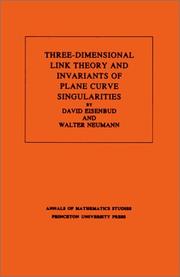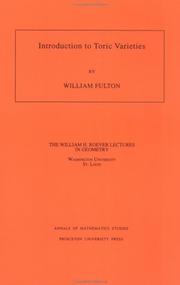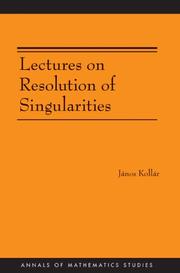| Listing 1 - 5 of 5 |
Sort by
|

ISBN: 0691083819 0691083800 1400881927 9780691083810 9780691083803 Year: 1985 Volume: 110 Publisher: Princeton (N.J.): Princeton university press,
Abstract | Keywords | Export | Availability | Bookmark
 Loading...
Loading...Choose an application
- Reference Manager
- EndNote
- RefWorks (Direct export to RefWorks)
This book gives a new foundation for the theory of links in 3-space modeled on the modern developmentby Jaco, Shalen, Johannson, Thurston et al. of the theory of 3-manifolds. The basic construction is a method of obtaining any link by "splicing" links of the simplest kinds, namely those whose exteriors are Seifert fibered or hyperbolic. This approach to link theory is particularly attractive since most invariants of links are additive under splicing.Specially distinguished from this viewpoint is the class of links, none of whose splice components is hyperbolic. It includes all links constructed by cabling and connected sums, in particular all links of singularities of complex plane curves. One of the main contributions of this monograph is the calculation of invariants of these classes of links, such as the Alexander polynomials, monodromy, and Seifert forms.
Algebraic geometry --- Differential geometry. Global analysis --- Link theory. --- Curves, Plane. --- SINGULARITIES (Mathematics) --- Curves, Plane --- Invariants --- Link theory --- Singularities (Mathematics) --- Geometry, Algebraic --- Low-dimensional topology --- Piecewise linear topology --- Higher plane curves --- Plane curves --- Invariants. --- 3-sphere. --- Alexander Grothendieck. --- Alexander polynomial. --- Algebraic curve. --- Algebraic equation. --- Algebraic geometry. --- Algebraic surface. --- Algorithm. --- Ambient space. --- Analytic function. --- Approximation. --- Big O notation. --- Call graph. --- Cartesian coordinate system. --- Characteristic polynomial. --- Closed-form expression. --- Cohomology. --- Computation. --- Conjecture. --- Connected sum. --- Contradiction. --- Coprime integers. --- Corollary. --- Curve. --- Cyclic group. --- Determinant. --- Diagram (category theory). --- Diffeomorphism. --- Dimension. --- Disjoint union. --- Eigenvalues and eigenvectors. --- Equation. --- Equivalence class. --- Euler number. --- Existential quantification. --- Exterior (topology). --- Fiber bundle. --- Fibration. --- Foliation. --- Fundamental group. --- Geometry. --- Graph (discrete mathematics). --- Ground field. --- Homeomorphism. --- Homology sphere. --- Identity matrix. --- Integer matrix. --- Intersection form (4-manifold). --- Isolated point. --- Isolated singularity. --- Jordan normal form. --- Knot theory. --- Mathematical induction. --- Monodromy matrix. --- Monodromy. --- N-sphere. --- Natural transformation. --- Newton polygon. --- Newton's method. --- Normal (geometry). --- Notation. --- Pairwise. --- Parametrization. --- Plane curve. --- Polynomial. --- Power series. --- Projective plane. --- Puiseux series. --- Quantity. --- Rational function. --- Resolution of singularities. --- Riemann sphere. --- Riemann surface. --- Root of unity. --- Scientific notation. --- Seifert surface. --- Set (mathematics). --- Sign (mathematics). --- Solid torus. --- Special case. --- Stereographic projection. --- Submanifold. --- Summation. --- Theorem. --- Three-dimensional space (mathematics). --- Topology. --- Torus knot. --- Torus. --- Tubular neighborhood. --- Unit circle. --- Unit vector. --- Unknot. --- Variable (mathematics).

ISBN: 0691000492 0691033323 1400882524 Year: 1993 Publisher: Princeton, N.J. Princeton University Press
Abstract | Keywords | Export | Availability | Bookmark
 Loading...
Loading...Choose an application
- Reference Manager
- EndNote
- RefWorks (Direct export to RefWorks)
Toric varieties are algebraic varieties arising from elementary geometric and combinatorial objects such as convex polytopes in Euclidean space with vertices on lattice points. Since many algebraic geometry notions such as singularities, birational maps, cycles, homology, intersection theory, and Riemann-Roch translate into simple facts about polytopes, toric varieties provide a marvelous source of examples in algebraic geometry. In the other direction, general facts from algebraic geometry have implications for such polytopes, such as to the problem of the number of lattice points they contain. In spite of the fact that toric varieties are very special in the spectrum of all algebraic varieties, they provide a remarkably useful testing ground for general theories.The aim of this mini-course is to develop the foundations of the study of toric varieties, with examples, and describe some of these relations and applications. The text concludes with Stanley's theorem characterizing the numbers of simplicies in each dimension in a convex simplicial polytope. Although some general theorems are quoted without proof, the concrete interpretations via simplicial geometry should make the text accessible to beginners in algebraic geometry.
Algebraic geometry --- Differential geometry. Global analysis --- 512.7 --- Algebraic geometry. Commutative rings and algebras --- Toric varieties. --- 512.7 Algebraic geometry. Commutative rings and algebras --- Toric varieties --- Embeddings, Torus --- Torus embeddings --- Varieties, Toric --- Algebraic varieties --- Addition. --- Affine plane. --- Affine space. --- Affine variety. --- Alexander Grothendieck. --- Alexander duality. --- Algebraic curve. --- Algebraic group. --- Atiyah–Singer index theorem. --- Automorphism. --- Betti number. --- Big O notation. --- Characteristic class. --- Chern class. --- Chow group. --- Codimension. --- Cohomology. --- Combinatorics. --- Commutative property. --- Complete intersection. --- Convex polytope. --- Convex set. --- Coprime integers. --- Cotangent space. --- Dedekind sum. --- Dimension (vector space). --- Dimension. --- Direct proof. --- Discrete valuation ring. --- Discrete valuation. --- Disjoint union. --- Divisor (algebraic geometry). --- Divisor. --- Dual basis. --- Dual space. --- Equation. --- Equivalence class. --- Equivariant K-theory. --- Euler characteristic. --- Exact sequence. --- Explicit formula. --- Facet (geometry). --- Fundamental group. --- Graded ring. --- Grassmannian. --- H-vector. --- Hirzebruch surface. --- Hodge theory. --- Homogeneous coordinates. --- Homomorphism. --- Hypersurface. --- Intersection theory. --- Invertible matrix. --- Invertible sheaf. --- Isoperimetric inequality. --- Lattice (group). --- Leray spectral sequence. --- Limit point. --- Line bundle. --- Line segment. --- Linear subspace. --- Local ring. --- Mathematical induction. --- Mixed volume. --- Moduli space. --- Moment map. --- Monotonic function. --- Natural number. --- Newton polygon. --- Open set. --- Picard group. --- Pick's theorem. --- Polytope. --- Projective space. --- Quadric. --- Quotient space (topology). --- Regular sequence. --- Relative interior. --- Resolution of singularities. --- Restriction (mathematics). --- Resultant. --- Riemann–Roch theorem. --- Serre duality. --- Sign (mathematics). --- Simplex. --- Simplicial complex. --- Simultaneous equations. --- Spectral sequence. --- Subgroup. --- Subset. --- Summation. --- Surjective function. --- Tangent bundle. --- Theorem. --- Topology. --- Toric variety. --- Unit disk. --- Vector space. --- Weil conjecture. --- Zariski topology.
Book
ISBN: 0691036810 0691036756 1400882540 9780691036755 9780691036816 Year: 1994 Volume: 133 Publisher: Princeton (N.J.): Princeton university press,
Abstract | Keywords | Export | Availability | Bookmark
 Loading...
Loading...Choose an application
- Reference Manager
- EndNote
- RefWorks (Direct export to RefWorks)
Written for advanced undergraduate and first-year graduate students, this book aims to introduce students to a serious level of p-adic analysis with important implications for number theory. The main object is the study of G-series, that is, power series y=aij=0 Ajxj with coefficients in an algebraic number field K. These series satisfy a linear differential equation Ly=0 with LIK(x) [d/dx] and have non-zero radii of convergence for each imbedding of K into the complex numbers. They have the further property that the common denominators of the first s coefficients go to infinity geometrically with the index s. After presenting a review of valuation theory and elementary p-adic analysis together with an application to the congruence zeta function, this book offers a detailed study of the p-adic properties of formal power series solutions of linear differential equations. In particular, the p-adic radii of convergence and the p-adic growth of coefficients are studied. Recent work of Christol, Bombieri, André, and Dwork is treated and augmented. The book concludes with Chudnovsky's theorem: the analytic continuation of a G -series is again a G -series. This book will be indispensable for those wishing to study the work of Bombieri and André on global relations and for the study of the arithmetic properties of solutions of ordinary differential equations.
Analyse p-adique --- H-fonction --- H-functie --- H-function --- p-adic analyse --- p-adic analysis --- H-functions --- H-functions. --- p-adic analysis. --- Analysis, p-adic --- Algebra --- Calculus --- Geometry, Algebraic --- Fox's H-function --- G-functions, Generalized --- Generalized G-functions --- Generalized Mellin-Barnes functions --- Mellin-Barnes functions, Generalized --- Hypergeometric functions --- Adjoint. --- Algebraic Method. --- Algebraic closure. --- Algebraic number field. --- Algebraic number theory. --- Algebraic variety. --- Algebraically closed field. --- Analytic continuation. --- Analytic function. --- Argument principle. --- Arithmetic. --- Automorphism. --- Bearing (navigation). --- Binomial series. --- Calculation. --- Cardinality. --- Cartesian coordinate system. --- Cauchy sequence. --- Cauchy's theorem (geometry). --- Coefficient. --- Cohomology. --- Commutative ring. --- Complete intersection. --- Complex analysis. --- Conjecture. --- Density theorem. --- Differential equation. --- Dimension (vector space). --- Direct sum. --- Discrete valuation. --- Eigenvalues and eigenvectors. --- Elliptic curve. --- Equation. --- Equivalence class. --- Estimation. --- Existential quantification. --- Exponential function. --- Exterior algebra. --- Field of fractions. --- Finite field. --- Formal power series. --- Fuchs' theorem. --- G-module. --- Galois extension. --- Galois group. --- General linear group. --- Generic point. --- Geometry. --- Hypergeometric function. --- Identity matrix. --- Inequality (mathematics). --- Intercept method. --- Irreducible element. --- Irreducible polynomial. --- Laurent series. --- Limit of a sequence. --- Linear differential equation. --- Lowest common denominator. --- Mathematical induction. --- Meromorphic function. --- Modular arithmetic. --- Module (mathematics). --- Monodromy. --- Monotonic function. --- Multiplicative group. --- Natural number. --- Newton polygon. --- Number theory. --- P-adic number. --- Parameter. --- Permutation. --- Polygon. --- Polynomial. --- Projective line. --- Q.E.D. --- Quadratic residue. --- Radius of convergence. --- Rational function. --- Rational number. --- Residue field. --- Riemann hypothesis. --- Ring of integers. --- Root of unity. --- Separable polynomial. --- Sequence. --- Siegel's lemma. --- Special case. --- Square root. --- Subring. --- Subset. --- Summation. --- Theorem. --- Topology of uniform convergence. --- Transpose. --- Triangle inequality. --- Unipotent. --- Valuation ring. --- Weil conjecture. --- Wronskian. --- Y-intercept.

ISBN: 0691129231 0691129223 9786612157745 1282157744 1400827809 9781400827800 9780691129228 9780691129235 9781282157743 Year: 2007 Publisher: Princeton, N.J. : Princeton University Press,
Abstract | Keywords | Export | Availability | Bookmark
 Loading...
Loading...Choose an application
- Reference Manager
- EndNote
- RefWorks (Direct export to RefWorks)
Resolution of singularities is a powerful and frequently used tool in algebraic geometry. In this book, János Kollár provides a comprehensive treatment of the characteristic 0 case. He describes more than a dozen proofs for curves, many based on the original papers of Newton, Riemann, and Noether. Kollár goes back to the original sources and presents them in a modern context. He addresses three methods for surfaces, and gives a self-contained and entirely elementary proof of a strong and functorial resolution in all dimensions. Based on a series of lectures at Princeton University and written in an informal yet lucid style, this book is aimed at readers who are interested in both the historical roots of the modern methods and in a simple and transparent proof of this important theorem.
Singularities (Mathematics) --- 512.761 --- Geometry, Algebraic --- Singularities. Singular points of algebraic varieties --- 512.761 Singularities. Singular points of algebraic varieties --- Adjunction formula. --- Algebraic closure. --- Algebraic geometry. --- Algebraic space. --- Algebraic surface. --- Algebraic variety. --- Approximation. --- Asymptotic analysis. --- Automorphism. --- Bernhard Riemann. --- Big O notation. --- Birational geometry. --- C0. --- Canonical singularity. --- Codimension. --- Cohomology. --- Commutative algebra. --- Complex analysis. --- Complex manifold. --- Computability. --- Continuous function. --- Coordinate system. --- Diagram (category theory). --- Differential geometry of surfaces. --- Dimension. --- Divisor. --- Du Val singularity. --- Dual graph. --- Embedding. --- Equation. --- Equivalence relation. --- Euclidean algorithm. --- Factorization. --- Functor. --- General position. --- Generic point. --- Geometric genus. --- Geometry. --- Hyperplane. --- Hypersurface. --- Integral domain. --- Intersection (set theory). --- Intersection number (graph theory). --- Intersection theory. --- Irreducible component. --- Isolated singularity. --- Laurent series. --- Line bundle. --- Linear space (geometry). --- Linear subspace. --- Mathematical induction. --- Mathematics. --- Maximal ideal. --- Morphism. --- Newton polygon. --- Noetherian ring. --- Noetherian. --- Open problem. --- Open set. --- P-adic number. --- Pairwise. --- Parametric equation. --- Partial derivative. --- Plane curve. --- Polynomial. --- Power series. --- Principal ideal. --- Principalization (algebra). --- Projective space. --- Projective variety. --- Proper morphism. --- Puiseux series. --- Quasi-projective variety. --- Rational function. --- Regular local ring. --- Resolution of singularities. --- Riemann surface. --- Ring theory. --- Ruler. --- Scientific notation. --- Sheaf (mathematics). --- Singularity theory. --- Smooth morphism. --- Smoothness. --- Special case. --- Subring. --- Summation. --- Surjective function. --- Tangent cone. --- Tangent space. --- Tangent. --- Taylor series. --- Theorem. --- Topology. --- Toric variety. --- Transversal (geometry). --- Variable (mathematics). --- Weierstrass preparation theorem. --- Weierstrass theorem. --- Zero set. --- Differential geometry. Global analysis
Book
ISBN: 0691082189 1322886407 0691628084 0691648328 1400867312 Year: 1978 Publisher: Princeton, N.J.
Abstract | Keywords | Export | Availability | Bookmark
 Loading...
Loading...Choose an application
- Reference Manager
- EndNote
- RefWorks (Direct export to RefWorks)
Written by Arthur Ogus on the basis of notes from Pierre Berthelot's seminar on crystalline cohomology at Princeton University in the spring of 1974, this book constitutes an informal introduction to a significant branch of algebraic geometry. Specifically, it provides the basic tools used in the study of crystalline cohomology of algebraic varieties in positive characteristic.Originally published in 1978.The Princeton Legacy Library uses the latest print-on-demand technology to again make available previously out-of-print books from the distinguished backlist of Princeton University Press. These editions preserve the original texts of these important books while presenting them in durable paperback and hardcover editions. The goal of the Princeton Legacy Library is to vastly increase access to the rich scholarly heritage found in the thousands of books published by Princeton University Press since its founding in 1905.
Algebraic geometry --- Geometry, Algebraic. --- Homology theory. --- Functions, Zeta. --- Zeta functions --- Cohomology theory --- Contrahomology theory --- Algebraic topology --- Geometry --- Abelian category. --- Additive map. --- Adjoint functors. --- Adjunction (field theory). --- Adjunction formula. --- Alexander Grothendieck. --- Algebra homomorphism. --- Artinian. --- Automorphism. --- Axiom. --- Banach space. --- Base change map. --- Base change. --- Betti number. --- Calculation. --- Cartesian product. --- Category of abelian groups. --- Characteristic polynomial. --- Characterization (mathematics). --- Closed immersion. --- Codimension. --- Coefficient. --- Cohomology. --- Cokernel. --- Commutative diagram. --- Commutative property. --- Commutative ring. --- Compact space. --- Corollary. --- Crystalline cohomology. --- De Rham cohomology. --- Degeneracy (mathematics). --- Derived category. --- Diagram (category theory). --- Differential operator. --- Discrete valuation ring. --- Divisibility rule. --- Dual basis. --- Eigenvalues and eigenvectors. --- Endomorphism. --- Epimorphism. --- Equation. --- Equivalence of categories. --- Exact sequence. --- Existential quantification. --- Explicit formula. --- Explicit formulae (L-function). --- Exponential type. --- Exterior algebra. --- Exterior derivative. --- Formal power series. --- Formal scheme. --- Frobenius endomorphism. --- Functor. --- Fundamental theorem. --- Hasse invariant. --- Hodge theory. --- Homotopy. --- Ideal (ring theory). --- Initial and terminal objects. --- Inverse image functor. --- Inverse limit. --- Inverse system. --- K-theory. --- Leray spectral sequence. --- Linear map. --- Linearization. --- Locally constant function. --- Mapping cone (homological algebra). --- Mathematical induction. --- Maximal ideal. --- Module (mathematics). --- Monomial. --- Monotonic function. --- Morphism. --- Natural transformation. --- Newton polygon. --- Noetherian ring. --- Noetherian. --- P-adic number. --- Polynomial. --- Power series. --- Presheaf (category theory). --- Projective module. --- Scientific notation. --- Series (mathematics). --- Sheaf (mathematics). --- Sheaf of modules. --- Special case. --- Spectral sequence. --- Subring. --- Subset. --- Symmetric algebra. --- Theorem. --- Topological space. --- Topology. --- Topos. --- Transitive relation. --- Universal property. --- Zariski topology. --- Geometrie algebrique --- Topologie algebrique --- Varietes algebriques --- Cohomologie
| Listing 1 - 5 of 5 |
Sort by
|

 Search
Search Feedback
Feedback About UniCat
About UniCat  Help
Help News
News